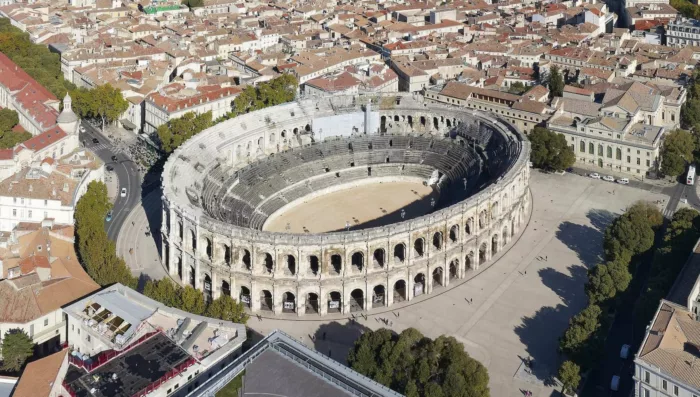Imagine a place where ancient Roman stones whisper tales of gladiatorial combat, sunshine paints the cafes with a golden glow, and modern hospitality offers a touch of indulgence. This is Nîmes, a captivating city in southern France, waiting to unfold its magic before you.
Nicknamed “the French Rome,” Nîmes boasts a wealth of Roman ruins rivaling the Eternal City. Just as 19th-century poet Jean Reboul once declared, Nîmes, like Rome, is a city built upon seven hills, bathed in sunshine, and graced with the beauty of its historical legacy.
The city sits proudly along the Via Domitia, an ancient road that once linked Italy to Spain, a testament to its former strategic importance. Prepare to be transported through time as you explore Nîmes.
Things to See in Nîmes
The Roman legacy of Nîmes unfolds like an open-air museum, inviting you on a captivating journey through the ages. Prepare to be awestruck by:
Arena of Nîmes

This behemoth, remarkably well-preserved, rivals the Colosseum itself. While the Colosseum bears the scars of medieval quarrying, Nîmes’ inhabitants cleverly repurposed theirs as a residential area. This act of preservation allows us to witness the near-complete structure today, with its arena, tiered seating, galleries, and arches standing strong – a captivating testament to the city’s rich history of spectacles. Today, the Arena of Nîmes pulsates with a different kind of energy, hosting concerts and cultural events.
Pont du Gard:

A short 30-minute drive beyond Nîmes lies the awe-inspiring Pont du Gard, a UNESCO World Heritage Site. This three-tiered aqueduct, a masterpiece of Roman ingenuity, stretches majestically across the Gardon River. Take a moment to marvel at its intricate stonework and imagine the vital role it played in transporting water to ancient Nîmes. If you’re feeling adventurous, you can even kayak here!
More Monuments, Maison Carrée and Temple de Diane:

Nîmes’ Roman treasures extend beyond the arena and aqueduct. Don’t miss the Maison Carrée, a perfectly proportioned temple recently added to the UNESCO World Heritage Site’s list. Other monuments include the Temple de Diane, Tour Magne, and Porte d’Auguste. These sites offer a glimpse into the daily life of the city’s Roman inhabitants and will spark your curiosity for exploration.
Things to Do in Nîmes
Nîmes isn’t just about reliving Roman history; it’s a city brimming with hidden gems waiting to be discovered.
Walk through the Jardins de la Fontaine

Step away from the bustle of the city center and find serenity in the Jardins de la Fontaine. These beautifully landscaped gardens offer a peaceful oasis, adorned with classical statues, cascading waterfalls, and serene walking paths. Immerse yourself in the sweet scent of blooming flowers and the gentle sound of trickling water, a perfect escape for a moment of quiet reflection.
Immerse yourself in the city’s museums: Musée de la Romanité and Carré d’Art

For those who crave a deeper cultural experience, Nîmes offers an array of museums. Delve into the city’s rich Roman heritage at the Musée de la Romanité, where captivating exhibits bring the past to life. If contemporary art interests you, head to the Carré d’Art, a vibrant space showcasing modern and experimental works.
Participate in the city’s festivities: Feria de Nîmes & Roman Days of Nîmes
Nîmes comes alive throughout the year with a vibrant calendar of festivals and events. Immerse yourself in the city’s spirit by attending the annual Feria de Nîmes, a thrilling bullfighting festival (courses camarguaises) unique to the region.
Alternatively, watch history come alive during the Roman Days of Nîmes, where the city transforms into an ancient Roman spectacle complete with gladiatorial games and costumed actors. No matter the season, Nîmes offers a unique opportunity to connect with its local culture and traditions.
Planning Your Nîmes Getaway
Nîmes is effortlessly accessible, whether you journey directly from Paris by high-speed train (3 hours), incorporate it into your exploration of Provence as a day trip from Aix-en-Provence or Avignon, or add it as a stop on a multi-region itinerary. Learn more about Roman History in Provence.
Where to Stay in Nîmes
Maison Albar – L’Imperator

This 5-star urban resort exudes timeless elegance, having charmed icons like Hemingway and Picasso. Choose from luxurious rooms or private houses, ideal for families or groups seeking an exclusive escape.
“…the mistral was blowing so they rode with the mistral down to Nîmes and stayed there at the Imperator.”
The Garden of Eden, Ernest Hemingway

Indulge your taste buds at DUENDE, the hotel’s 2-Michelin-starred restaurant led by culinary maestro Pierre Gagnaire. His creations are a testament to his innovative spirit and dedication to artistry. Unwind at the expansive Codage Spa, a sanctuary of pampering, or sip handcrafted cocktails at Bar Hemingway, a tribute to the famed writer who frequented this very spot. Maison Albar – L’Imperator allows you to experience Nîmes’ rich heritage in the lap of luxury.
Margaret – Hôtel Chouleur

For a stay that feels more like a private residence than a hotel, look no further than Margaret – Hôtel Chouleur. Nestled on a quiet street, this charming 4-star hotel boasts just 10 rooms and suites, designed with a blend of French tradition and modern flair. Relax in one of the hotel’s two courtyards, or lose yourself in a good book in the library. Here, you can pour yourself a drink and settle up at the end of your stay, fostering a relaxed and intimate atmosphere.

For a truly unforgettable experience don’t miss ROUGE, the on-site Michelin-starred restaurant. Chef Georgiana Viou’s culinary creations showcase the best of Mediterranean cuisine. Just steps from the Maison Carrée, Margaret – Hôtel Chouleur is perfect for those seeking a personalized experience in the heart of Nîmes.
Nîmes’ allure is derived from its blend of Roman heritage, sun-drenched charm, and contemporary elegance. Ancient stones whisper of the past, vibrant cafes hum with life, and unique experiences await around every corner.
Ready to explore? Let our Travel Designers curate your perfect French escape. Speak with an expert today to unveil the magic of Nîmes.
























































































